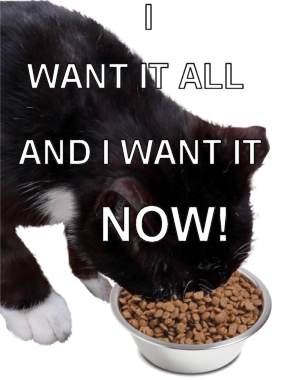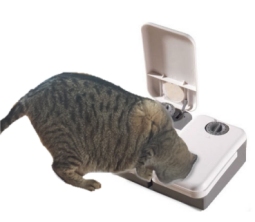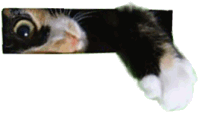Is your cat a speed eater?

There are several reasons why a cat might eat too fast. One is simply that your cat is very hungry. This may not imply any neglect on your part – perhaps even the opposite. No overweight cat appreciates being put on a diet, and in such cases the cat's natural reaction to meeting food is to get it inside her as fast as she can, simply because it's there and she loves eating the stuff.
A second reason for fast eating is insecurity. If your cat is unhappy about the location of her food bowl and feels vulnerable while eating, then the natural response is to eat as quickly as possible. This can become a learned reaction, so even though the food is now located in a totally safe corner of the house, your cat has picked up the idea that food should be eaten at high speed. The same is true of cats in a multi-pet household, where the fastest eaters get to move in on the food of slower eaters. Soon every meal becomes a competitive eating event. Again this is a learned behaviour, so your cat might have become a speed-eating champ after getting muscled off mummy's teat once too often as a kitten.
That said, your cat wolfing down food is not an ideal situation. For a start, a speed-eater might gulp down something – for example a bone or lump of meat – that gets stuck in her throat and leads to choking. Cats have their airways located further back in the throat than the - frankly hazardous - design of human systems, but speed eating can nullify nature's built-in precautions.
Secondly, with both cats and humans, eating too fast can lead to obesity. This is because when one takes the time to chew slowly through a meal, the stomach releases chemical signals that tell the brain that the body has eaten enough, and it is time to dial back the appetite response. However, if a huge amount of food is thrown at the stomach in a very short time, by the time the body gets around to suppressing appetite, it already has more food in it than it needs - and of course, the surplus is turned into fat.
Getting more food than can be handled at any one time can also cause other problems for the digestive system. Just as with humans who bolt down their food too fast, a speed-eating cat can suffer from wind, stomach cramps and indigestion. Overall, getting your cat to take her time over meals is a good idea with no actual disadvantages. So the question is, how to do it?
First of all, check the security issue. If your cat's food bowl is located right next to the dog's, then you can hardly blame your cat for wanting to get maximum food inside herself before the dog has finished dinner. And even if the dog eats at the opposite side of the house, your cat will still appreciate a feeding location where she can at least spot trouble coming. This may resolve the real problem, but you still have to break the learned response if your cat continues to eat too quickly.
Next, take a look at the design of the food bowl. This is probably deep and curved, somewhat like the bowl from which you eat your breakfast cereal. It is a bowl designed more for the convenience of humans than cats, because even with a deep bowl a speed-eating cat has less a feeding area and more of a blast radius where the bowl sits in the middle of an explosion of cat food. Yet oddly enough, a flat bowl may actually solve the problem in some cases.
A larger, flat dish with the food spread thinly across the bottom is not a dish that a cat can plunge into up to the eyeballs. The cat is forced to lick and pick her way across the expanse, which slows her down, and allows plenty of time for the stomach's satiation signals to reach her hungry little brain. It also means that food is not stacked deeply enough to be easily sprayed about, and this can result in a tidier eating area.
Another solution is to make it harder for the cat to get at her food. Something large and indigestible, such as an inverted teacup forces the cat to eat around the obstacle and this again slows her down. In fact some pet shops sell food bowls with built-in bumps for just this purpose, so if the teacup idea works, it maybe worthwhile looking around for one of these bowls. You might also want to take the idea to an extreme and – with dry food – stash dinner in one of those toys like a ball that dribbles a bit of cat biscuit every time it is whacked. This not only makes dinnertime a drawn-out process, but if your cat buys into the idea, she will also get some healthy exercise while she is at it.

You can take the idea further, and hide the food-producing toys around the house. While this replicates the cat's natural hunter-browser feeding habits, some pet owners have reported that this also broadens the cat's idea of what constitutes 'her' food. Suddenly the meat defrosting on the kitchen counter is less safe, and the cat might try your hand lotion on the off-chance it is a cunningly-concealed edible snack.
A better idea maybe to feed your cat less food more often. Instead of two large meals a day, try six small ones. That way the cat has to stop after eating a moderate amount of food because there isn't any more food available anyway. This gives the satiation signal time to kick in, and the cat will be more prepared to wait until the next meal – especially as it is no longer that long to wait. This technique is less effective with cats which make a hobby of seeing how much food they can persuade humans to part with, whether they are hungry or not.
The plan is also sub-optimal for humans who have to go to work in the day, and have no choice but to give the cat a large meal before they rush out of the door. In either case, an automatic feeder dispensing small amounts of food at set intervals solves the problem. Even the most persistent cat soon learns that her hypnotic powers of persuasion do not work on machinery.
The last, and least likeable idea is to replace the food your cat really likes with something she will only eat with reluctance when she is really hungry. This works to break the speed-eating habit, but imagine how you would feel if your favourite food was suddenly replaced with bland oatmeal at dinner time. Sometimes you have to be cruel to be kind, but only as a last resort.

